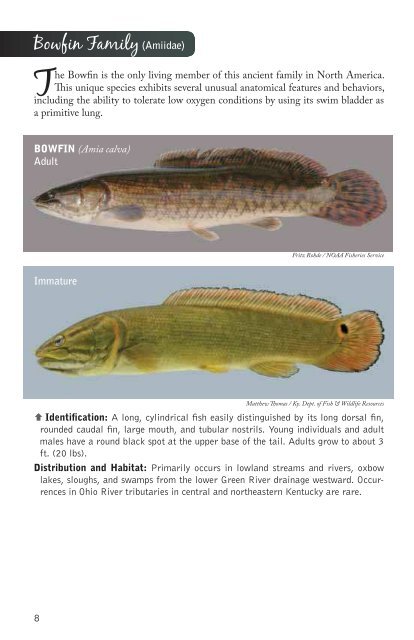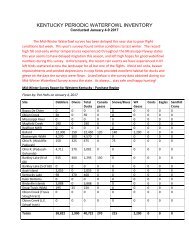Kentucky Fishes
kyfishid[1]
kyfishid[1]
- No tags were found...
Create successful ePaper yourself
Turn your PDF publications into a flip-book with our unique Google optimized e-Paper software.
Bowfin Family (Amiidae)<br />
The Bowfin is the only living member of this ancient family in North America.<br />
This unique species exhibits several unusual anatomical features and behaviors,<br />
including the ability to tolerate low oxygen conditions by using its swim bladder as<br />
a primitive lung.<br />
Mooneye Family (Hiodontidae)<br />
This family is restricted to North America and contains only two species, both<br />
of which occur in <strong>Kentucky</strong>. Mooneyes have teeth on the jaws, tongue, and<br />
roof of the mouth. They are sometimes called “toothed herrings” because of their<br />
resemblance to herrings, but the two groups are not closely related. Both species feed<br />
mostly on insects and small fishes near the surface of the water.<br />
BOWFIN (Amia calva)<br />
Adult<br />
Immature<br />
Fritz Rohde / NOAA Fisheries Service<br />
GOLDEYE (Hiodon alosoides)<br />
Matthew Thomas / Ky. Dept. of Fish & Wildlife Resources<br />
MOONEYE (Hiodon tergisus)<br />
Matthew Thomas / Ky. Dept. of Fish & Wildlife Resources<br />
Ç Identification: A long, cylindrical fish easily distinguished by its long dorsal fin,<br />
rounded caudal fin, large mouth, and tubular nostrils. Young individuals and adult<br />
males have a round black spot at the upper base of the tail. Adults grow to about 3<br />
ft. (20 lbs).<br />
Distribution and Habitat: Primarily occurs in lowland streams and rivers, oxbow<br />
lakes, sloughs, and swamps from the lower Green River drainage westward. Occurrences<br />
in Ohio River tributaries in central and northeastern <strong>Kentucky</strong> are rare.<br />
Uland Thomas / North American Native <strong>Fishes</strong> Association<br />
Ç Identification: The mooneyes are silvery, deep-bodied, and thin (shad-like). They<br />
differ from shad and herrings by having a lateral line (vs. absent) and a smooth (vs.<br />
saw-toothed) keel along the belly. The Goldeye is similar to the Mooneye, but differs<br />
by having the dorsal fin origin in front of the anal fin origin (vs. dorsal fin origin behind<br />
anal fin origin) and fleshy keel along the belly extending from between the pelvic<br />
fins to the anal fin base (vs. keel extending from between the pectoral fins to the anal<br />
fin base). The Goldeye grows to about 20 in. and the Mooneye reaches about 18 in.<br />
Distribution and Habitat: Both Goldeye and Mooneye occur in deep pools and channels<br />
of medium to large rivers throughout the state. Although both species are relatively<br />
common in the Ohio and Mississippi Rivers, the Mooneye tends to be more<br />
common in higher gradient tributaries, whereas the Goldeye appears to favor larger<br />
lowland rivers. Both species have also been found in large reservoirs.<br />
8 9



